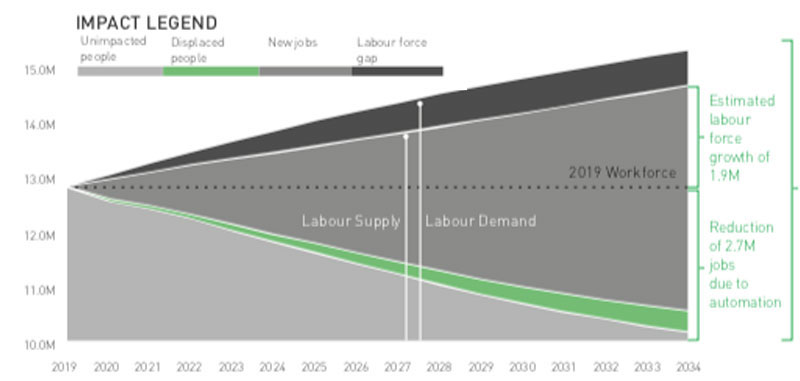Automation Puts Real Estate Jobs at Risk
Automation technology will displace 21 per cent of the Australian workforce during the next 15 years—but with the right approach from both industry and government, twice as many roles could be created.
The Technology Impacts on the Australian Workforce report uses census data on employment categories to examine how Australia's major industries will be affected by automation technology.
Prepared by AI work analytics platform Faethm and ACS, the report predicts both opportunities and challenges ahead for the Australian workforce, as various industries are either augmented by technology, or become more susceptible to automation.
While automation will displace 2.7 million workers—21 per cent of the workforce—by 2034, the good news is that the same technological advancement brought on by the digital revolution will also augment 4.5 million workers, leading to a 15 per cent capacity uplift to Australian businesses.
Automation and augmentation will differ based on underlying skills and activities for individual roles, with key positions impacted including metal fabricators and fitters (7,400 jobs at risk); and truck drivers (18,700 at risk).
In the construction sector, the report reveals that while 290,000 jobs are at risk from automation during the next 15 years—87 per cent of which are male—the majority of roles are more subject to augmentation, rather than automation, and actually stand to benefit from technologies such as fixed and navigation robotics, and process automation.
Similarly, in the real estate services sector 36,000 jobs are in jeopardy—58 per cent of which are female—most roles are more subject to augmentation, rather than automation.
In the manufacturing sector, while 193,000 jobs are at risk from automation during the next 15 years—75 per cent of which are male—again, most are more subject to augmentation, rather than automation, and, like the construction industry, will reap the rewards of technological advances.
The benefits of automation

Gender composition of roles within and industry is key to understanding the differing impact of technology by gender, the report shows.
For example, in the real estate sector, the over-representation of women in positions such as reception or administration drives the higher level of automation among females.
By comparison, males experience higher rates of employment in the construction sector, which is anticipated to see higher levels of augmentation rather than automation, the report found.
Regardless of gender, many at-risk professionals also have transferable skills, and need only focus on skills and knowledge gaps in order to transition to new, lower-risk occupations.
A structural steel and welding trades worker could transition to, say, a solar photovoltaic installer; and a delivery driver could become a personal care consultant and a real estate receptionist could make the leap into sales.
ACS chief executive Andrew Johnson said the report could help address imbalances between the adaptability and future-readiness of workers across industries.
“The outcomes ... provide deep insights for businesses to inform future workforce development plans, as well as for policy makers to maximise the participation rate of all citizens in the opportunities afforded by the ‘fourth industrial revolution’,” Johnson said.
The report’s authors call for a “macro, cross-policy approach” by governments to address the impact of technology on the workforce.
















